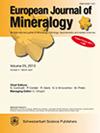美国蒙大拿州怀俄明州北部熊牙山脉东部太古宙麻粒岩相变质沉积岩性的变质P–T路径:石榴石中石英(QuiG)拉曼弹性气压计、地热测量和热力学建模的约束
IF 1.7
3区 地球科学
Q2 MINERALOGY
引用次数: 0
摘要
摘要采用成像、分析和建模相结合的方法,建立了怀俄明州蒙大拿州东部熊牙山脉晚太古宙高品位岩石的变质压力和温度(P–T)路径。石榴石包裹体的机械和化学热压测量法应用于几个麻粒岩相混合岩和一个铁质地层,在约束进积P–T条件方面特别有用。石榴石中的石英(QuiG)弹性拉曼气压计用于研究所有样品的石榴石中的晶体包裹体。对于四个代表性样品中的一小部分,QuiG约束与石英中的Ti(TiTiQ)和黑云母中的TiB(TiB)测温结合使用,以建立渐进包裹体包裹P–T条件。采用石榴石主体的Ti测量和夹杂物和基质石英晶粒的阴极发光(CL)图像来检查Ti的损失/扩散。最后,包裹体研究辅以热力学建模和基质化学热压测量法,以检查石榴石成核温度和峰值变形条件。用于计算石英包裹体压力的体积应变和弹性张量方法之间的差异表明,所研究的石英包裹体处于强微分应变下。所用的两个包裹体温压测量对的逐步截留结果不同:0.55–0.70 GPa和475–580 ∘C(QuiG–TitaniQ)与0.85–1.10 GPa和665-780 ∘C(测验–测验)。石榴石模态等值线模型表明,石榴石的主要生长发生在 450–600 ∘C、 这意味着石榴石生长的P–T条件被解释为最可靠地用QuiG–TitaniQ包裹体温度气压计来表示。计算的QuiG包裹体压力和石榴石核中矿物包裹体浓度的正态分布表明,大多数石榴石包裹体是在斑状体生长的单个阶段被包裹的。CL图像中普遍缺乏对石英包裹体进行包埋后机械或化学修饰的证据,这表明用于计算包埋P–T的石英包裹体在很大程度上保留了其初始包埋条件。在相同的石榴石中,黑云母包裹体比石英包裹体保持更高的温度,这可能是由于与石榴石的Fe–Mg交换,使得黑云母的Ti含量在包裹后发生变化。包裹体研究期间检查的多个独立岩性的假剖面建模和基质化学热压测量表明 0.50–0.70 GPa和730–800 ∘C.本研究的峰值变质P–T建模工作,以及区域角闪岩相叠加不均匀相邻样品的证据,表明整个顺时针变质P–Tpath具有几乎等压的进程加热至峰值温度。解释的P–T路径重建与在更现代风格的大陆弧俯冲带中发育的变质作用一致,并在怀俄明州北部的部分地区观察到,例如熊齿山脉东部的变质表壳地质。本文章由计算机程序翻译,如有差异,请以英文原文为准。
Metamorphic P–T paths of Archean granulite facies metasedimentary lithologies from the eastern Beartooth Mountains of the northern Wyoming Province, Montana, USA: constraints from quartz-in-garnet (QuiG) Raman elastic barometry, geothermobarometry, and thermodynamic modeling
Abstract. Metamorphic pressure and temperature (P–T) paths in late-Archean
high-grade rocks of the eastern Beartooth Mountains of Montana (USA), a
portion of the Wyoming Province, are established by a combination of
imaging, analytical, and modeling approaches. Garnet inclusion mechanical
and chemical thermobarometry, applied to several granulite-facies migmatites
and an iron formation, is particularly useful in constraining the prograde
P–T conditions. Quartz-in-garnet (QuiG) elastic Raman barometry was used on
quartz inclusions in garnet for all samples studied. For a smaller subset of
four representative samples, QuiG constraints were used in conjunction with
Ti-in-quartz (TitaniQ) and Ti-in-biotite (TiB) thermometry to establish
unique prograde inclusion entrapment P–T conditions. Ti measurements of
garnet hosts and cathodoluminescence (CL) imagery of inclusion and matrix
quartz grains were employed to check for Ti loss/diffusion. Lastly,
inclusion studies were supplemented with thermodynamic modeling and matrix
chemical thermobarometry to examine garnet nucleation temperatures and peak
metamorphic conditions. Disagreement between the volume strain and elastic tensor methods used to
calculate quartz inclusion pressures implies that quartz inclusions studied
are under strong differential strain. Prograde entrapment results from the
two inclusion thermobarometry pairs used are distinct: 0.55–0.70 GPa and
475–580 ∘C (QuiG–TitaniQ) versus 0.85–1.10 GPa and 665–780 ∘C (QuiG–TiB). Garnet modal isopleth modeling indicates that the
majority of garnet growth occurred at ∼ 450–600 ∘C,
implying that P–T conditions of garnet growth are interpreted to be most
reliably represented by QuiG–TitaniQ inclusion thermobarometry. Normal
distributions of calculated QuiG inclusion pressures and the concentration
of mineral inclusions in garnet cores suggest that the majority of garnet
inclusions were entrapped during a single stage of porphyroblast growth. A
general lack of evidence from CL imagery for post-entrapment mechanical or
chemical modifications to quartz inclusions suggests that quartz inclusions
used to calculate entrapment P–T largely preserve their initial entrapment
conditions. Biotite inclusions preserve higher temperatures than quartz
inclusions in the same garnets, likely due to Fe–Mg exchange with garnet
hosts that allowed Ti content of biotite to change after entrapment.
Pseudosection modeling and matrix chemical thermobarometry of multiple,
independent lithologies examined during inclusion studies suggest a range of
peak granulite facies conditions of ∼ 0.50–0.70 GPa and
730–800 ∘C. Peak metamorphic P–T modeling work from this study,
together with evidence of regional amphibolite facies overprinting in
immediately adjacent samples, indicates an overall clockwise metamorphic P–T
path with nearly isobaric prograde heating to peak temperatures. Interpreted
P–T path reconstructions are consistent with metamorphism developed in a
more modern-style continental arc subduction zone and are observed in
portions of the northern Wyoming Province as exemplified by metasupracrustal
lithologies of the eastern Beartooth Mountains.
求助全文
通过发布文献求助,成功后即可免费获取论文全文。
去求助
来源期刊
CiteScore
2.80
自引率
9.50%
发文量
40
审稿时长
6-12 weeks
期刊介绍:
EJM was founded to reach a large audience on an international scale and also for achieving closer cooperation of European countries in the publication of scientific results. The founding societies have set themselves the task of publishing a journal of the highest standard open to all scientists performing mineralogical research in the widest sense of the term, all over the world. Contributions will therefore be published primarily in English.
EJM publishes original papers, review articles and letters dealing with the mineralogical sciences s.l., primarily mineralogy, petrology, geochemistry, crystallography and ore deposits, but also biomineralogy, environmental, applied and technical mineralogy. Nevertheless, papers in any related field, including cultural heritage, will be considered.

 求助内容:
求助内容: 应助结果提醒方式:
应助结果提醒方式:


